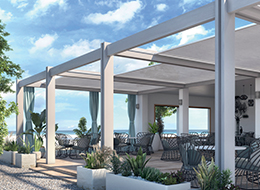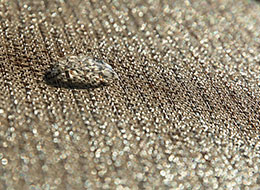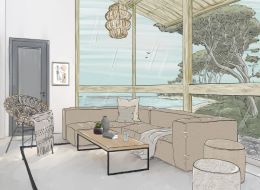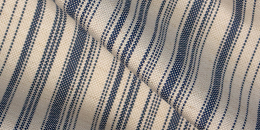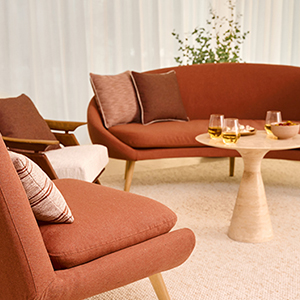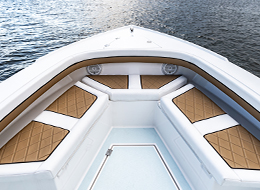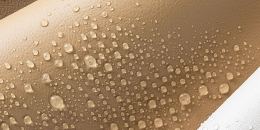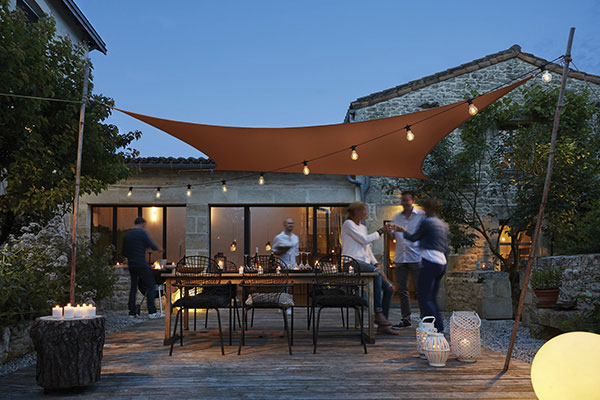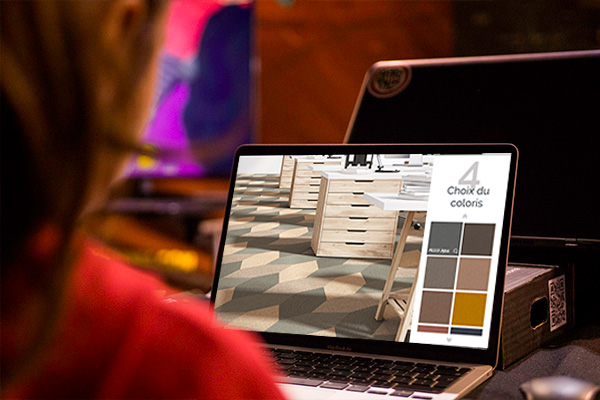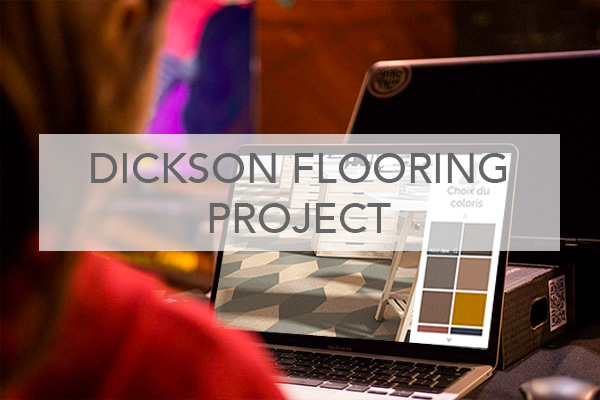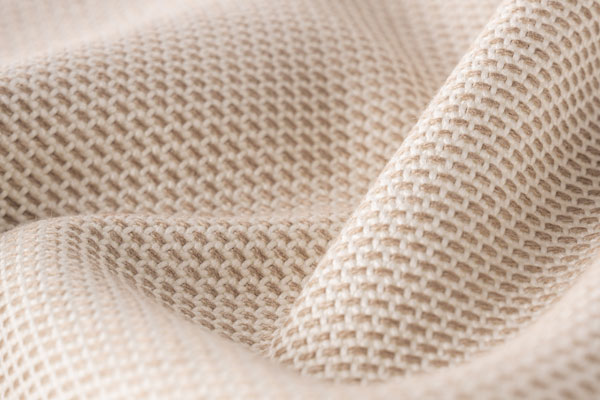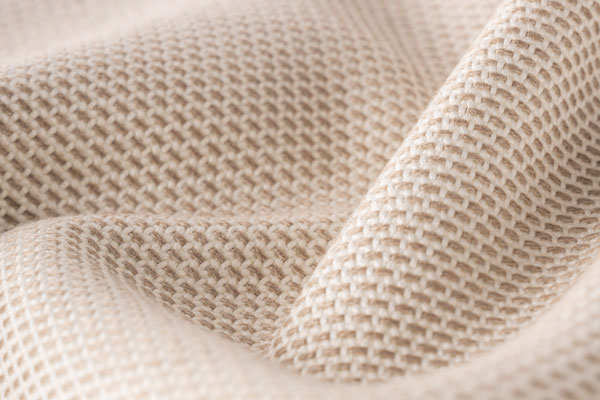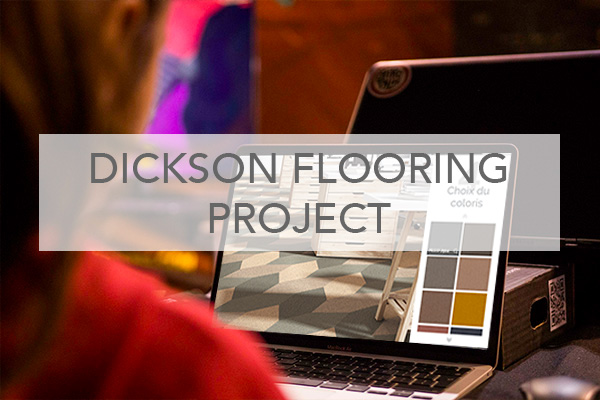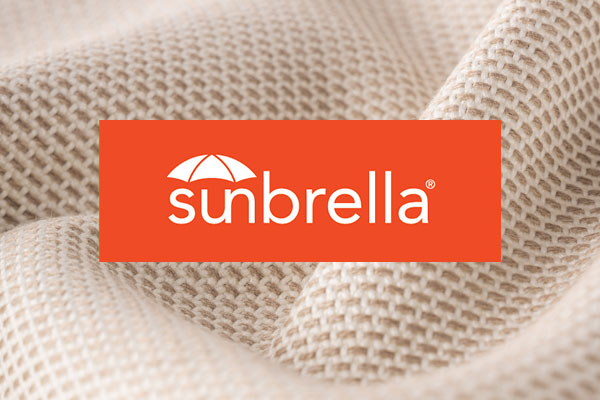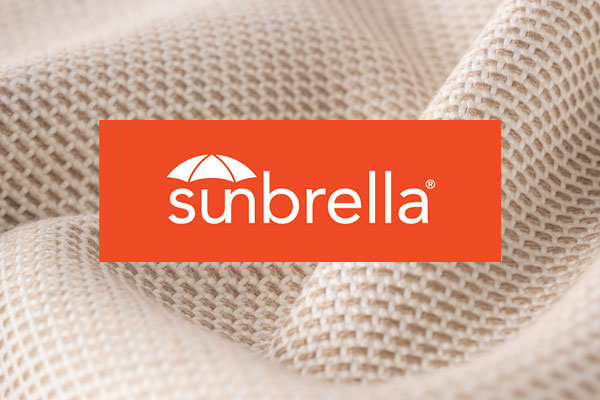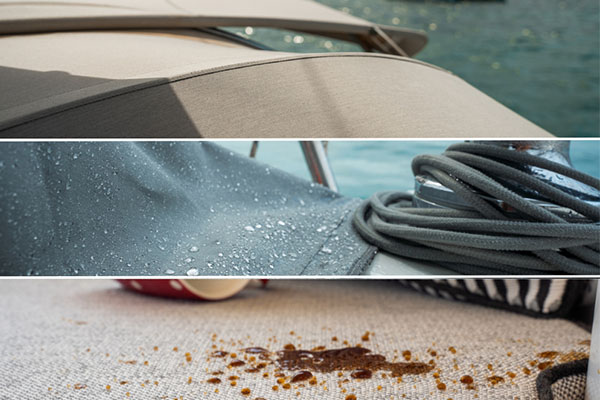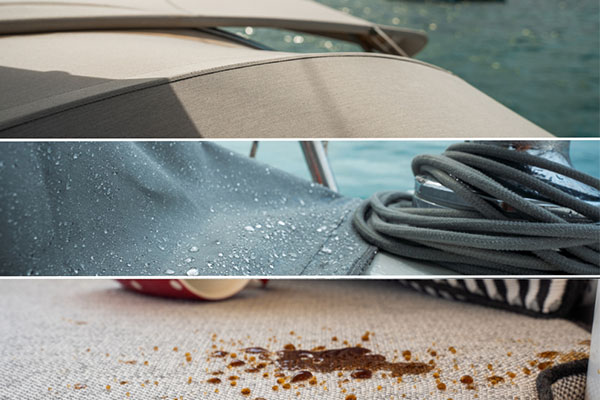With your permission, Dickson may use cookies to improve your experience on our application/websites.
For more information, click here..
What material are Sunbrella fabrics made from?
Sunbrella® fabrics are woven from solution-dyed acrylic Sunbrella® fibres. The colour pigments are mixed into the acrylic in a liquid state, so the fibre is saturated with pigments for incomparable UV stability and the UV colour fastness is exceptional.
Am I buying a French product?
Our core range is woven in Wasquehal, in the north of France, by expert weavers. Our fabrics are the result of cooperative effort between our research and development teams and our Sunbrella design studio based at the Wasquehal headquarters.
We complete our collection to offer you a complete selection with ranges woven at Sunbrella in the USA: Seamark, Surlast, Heritage, Horizon, Loop.
We benefit from their complete expertise of the Sunbrella brand which has been an international benchmark for over 50 years.
Is it easy to make with Sunbrella?
Sunbrella marine fabrics are ideal for a variety of marine applications, such as boat shades, boat saddlery, boat awnings or bimini tops and closures. One of the best reasons why marine manufacturers and saddlers choose Sunbrella is that it is easy to work with and it performs wonderfully during application. Sunbrella fabrics are lighter and more flexible while remaining extremely durable, making them easy to install. Sunbrella fabrics are also available in a large range of widths to accommodate marine applications of all sizes
Can I make my own cover/awning etc?
We have detailed manufacturing guides for each range. Please feel free to request them from us contact@dickson-constant.com
Which fabric should I choose for which application?
Discover all our applications for Sunbrella Marine protective fabric and nautical equipment fabrics.
Will the colour last and not fade over time/Is the fabric fade resistant?
Sunbrella fabric is made from 100% solution-dyed acrylic fibre. The distinguishing feature of solution-dyed acrylic lies in its manufacture. The colour is put directly into the melt before the fibre is made. The colour is therefore at the core of the fibre, and this gives it excellent UV resistance. Sunbrella covers its fabrics with the most comprehensive warranty in the industry for loss of colour or strength.
Is Sunbrella fabric soft to the touch?
Sunbrella fabrics are made from solution-dyed acrylic, giving you a fabric that is stain and fade resistant, yet soft and comfortable to the touch.
Does Sunbrella fabric provide UV protection?
Sunbrella fabric has been tested and found to have over 98% protection against the sun's harmful UV rays. This protection varies depending on the colours, the nature of the product (Sunbrella Plus, uncoated Sunbrella, Sunbrella Seamark etc.) and its thickness. White and light colours provide less protection than dark colours. (Range from 90% for very light colours to 95% for medium colours and 100% protection for dark colours). This protection factor is inherent to the product and is not altered by its use and exposure to the sun.
How do I know if a fabric is waterproof?
Reference should be made to the water column test. This test evaluates the waterproofness, i.e. it measures the resistance of a fabric to the pressure of water. The higher the water column value, the more difficult it is for water to get through the fabric. Also known as Schmerber, it is measured in millimetres. Our Seamark fabric is completely waterproof (Schmerber over 3,500mm) and our Sunbrella Plus also has a very high waterproof rating (1,000 mm)
Will the fabric be weather, friction and moisture resistant?
We test dimensional stability, i.e. the fabric's ability to keep its shape when subjected to mechanical actions, changes in moisture and/or ambient temperature or wetting and drying. The result is shown in %
Elongation and tensile strength (ISO 13934-1 test) and tear strength (ISO 13937-1 test) are also tested
We can guarantee that Sunbrella fabrics are extremely strong
Is the fabric resistant to moisture?
Our fabrics are tested with the spray test (ISO 4920). This is a laboratory test that is conducted to determine the resistance of fabrics to surface moisture. In this test, the fabric is sprayed with an “artificial rain”, in particular to see if water doesn't pass through the fabric.
We can guarantee that all Sunbrella fabrics have excellent damp proofing.
Can the fabric become mouldy?
One of the main characteristics of Sunbrella fabric is the nature of its fibre. Solution-dyed acrylic is rot-proof, unlike natural fibres such as cotton. However, it is recommended to clean the fabric regularly to avoid the formation of mould on the surface. (See care tips). In addition, we measure breathability, i.e. the passage of air to avoid moisture, which is a factor for mould, by measuring air permeability (ISO 9237 measurement).
Will pilling occur on Sunbrella fabrics for seats and cushions?
We test the behaviour and resistance of our fabrics to friction and abrasion with, in particular, the Martindale test (NF EN ISO 12947 standard), as well as the WYZENBEEK test (ASTM 4157 standard).
What can I do to prevent mould from growing on the fabric?
Sunbrella Plus has high resistance to water, so if the application (winter cover, bimini top etc.) is not properly ventilated and cleaned regularly, it may be susceptible to mould. For mould to grow, four components must be present: heat, moisture, spores and a food source, which provide the "bed" for mould to grow. Although Sunbrella Plus fabric is rot-proof (doesn't support mould growth) because the raw material used is solution-dyed acrylic (synthetic thread), mould can grow on dirt on the fabric. That's why it is important to keep your Sunbrella fabrics clean and dirt-free.
One of the best ways to care for your fabrics is to look after them monthly by brushing them with a soft brush then rinsing with clean water. This practice will help prevent dirt from becoming deeply embedded into the fabric and eliminate the need for more frequent vigorous cleaning. For more information, please refer to the warranty certificate and the “Care tips for outdoor fabric” leaflet.
How do I care for and clean my Sunbrella cushions and seats?
One of the best ways to maintain the appearance of Sunbrella® fabrics is to brush off dirt before it becomes embedded in the fabric and wipe up liquids immediately or deal with a stain as quickly as possible. The quicker liquids and stains are cleaned, the easier they can be removed.
For a new stain on your Sunbrella fabric:
- Dab any spilled liquids (don't scrub) with a clean, dry cloth.
- For oil or oily stains, apply something absorbent, like corn starch, then clean with a squeegee.
- Make up a cleaning solution by mixing water and mild soap.
- Rinse the fabric carefully to remove all soap residue.
- Let it air dry.
Cleaning removable fabric
- Hand wash
- Soak the fabric in a solution of 150 ml of mild soap per litre of warm water. Use a sponge or very soft brush to gently agitate the stain. Then rinse thoroughly to remove any soap residue and let the fabric air dry.
Machine wash
- Some covers can be machine washed, but it is better to consult the furniture manufacturer before removing the cover, as padding production can vary.
- To wash, first close all zips.
- Machine wash in cold water on a gentle cycle with the usual amount of mild laundry detergent.
- For stubborn mould stains, add 60 ml of bleach. Let the fabric air dry.
Cleaning non-removable fabric
- Make up a solution of 150 ml of mild soap per litre of warm water. Use a soft brush to clean and let the cleaning solution soak into the fabric. Then rinse thoroughly to remove any soap residue and let the fabric air dry.
- Pour les instructions de nettoyage de taches tenaces, consultez notre tableau des taches. www.sunbrella.com/stainchart
How do I clean and care for my awning, bimini top, cover, spray hood?
The best way to maintain the appearance of Sunbrella® fabrics is to hose them down monthly with clean water. This will prevent dirt from becoming deeply embedded in the fabric and eliminate the need for more frequent vigorous cleaning. In most environments, a thorough clean will be required every two to three years.
General or light cleaning
To clean Sunbrella fabrics directly on the boat, follow these simple steps
- Remove dust with a brush.
- Hose down.
- Make up a cleaning solution by mixing water and mild soap or washing-up liquid.
- Clean with a soft-bristle brush.
- Wait for the cleaning solution to soak into the fabric.
- Rinse thoroughly until all soapy residue is removed.
- Let it air dry.
- May not need to be re-treated, depending on the age of the fabric.
Intensive cleaning
Sunbrella fabric doesn't encourage mould growth, however, mould can appear if dirt and other substances are left on them. For stubborn stains and mould:
- Make up a solution of 60 ml of bleach and 150 ml of soap per litre of clean water.
- Soak the fabric in the mixture for 15 minutes.
- Dab the stain with a clean sponge or tissue. (Note: this step should be avoided when cleaning the coated side (back) of Sunbrella Plus fabrics.)
- Rinse thoroughly until all soapy residue is removed.
- Let it air dry.
Be careful to respect the environment, we do not recommend the use of bleach if you are surrounded by an area of water or other environment that may be affected.
Is it possible to retreat my coated Sunbrella fabric?
Sunbrella fabrics are treated with a patented waterproof and stain-resistant coating that is designed to last for several years but may need to be restored following a deep clean. Dickson and Sunbrella recommend TEX AKTIV CLEAN and GUARD products, which are available from your regular Sunbrella reseller.
How do I apply the TEX AKTIV CLEAN and TEX AKTIV GUARD treatments?
Clean Sunbrella fabric using one of the cleaning methods described. Let the Sunbrella fabric air dry completely. Apply in a well-ventilated area following the instructions on the packaging. More information
Can I clean Sunbrella fabric with a high-pressure cleaner?
High-pressure cleaning is not permitted, as it can cause irreversible damage to the fabric.
Can I use bleach?
Yes, on indoor and outdoor upholstery fabrics and on uncoated Sunbrella.
Click here for full information on maintenance and cleaning
Is it normal to see white lines on the fabric?
You have noticed white lines on your Sunbrella® fabric and you're wondering what they are. Our fabrics are woven from solution-dyed acrylic fibre for higher quality, and they receive our full attention during the manufacturing process. However, you may notice some minor imperfections after your marine cover is in place. These “white fold lines” can sometimes be seen on the following Sunbrella® colours: Beige, Taupe, Dune, Toast & Charcoal Grey.
These white lines are caused by folding or creasing of the fabric during the handling phase (installation on the boat or sewing). However, these white marks do not affect the performance of your fabric.
Over time, these marks tend to fade. The main factor contributing to the marking is a fluororesin; this is added to Sunbrella® fabrics at the final finishing stage to increase rigidity, stain resistance and oil-repelling properties, but unfortunately it also increases the fabric's susceptibility to marking and white lines.
For many years we have been working closely with our chemical suppliers to find a solution, but to date, no other product to replace this fluororesin-based coating has been found.
What should I do if the seams leak?
We have a sewing guide with recommendations for sewing and also for the sewing thread (RASANT n°25WR polyester/cotton AMANN GROUP)
RASANT n°25WR: is a water resistant (WR) thread. It boosts waterproofness of the seams thanks to the water resistant (WR) treatment.
When saddlers use this thread, the waterproofness is excellent. Note, this thread “swells” with water, so it takes one or two showers before the fabric/seam is watertight.
Our new PU-coated Sunbrella Plus can now be welded with tape, which helps avoid this problem of leakage at the seams.
Are Sunbrella fabrics good for me and the environment?
Our fabrics are Greenguard certified, which means that Sunbrella® textiles contribute to creating a healthy indoor environment with regard to chemical emissions.
Our fabrics are also OEKO TEX certified, i.e. they are free of identified hazardous substances that may pose a danger to health, skin and the environment.
Sunbrella has also developed treatments that are designed and applied in strict compliance with European REACH regulations.
Is it environmentally friendly to buy Sunbrella fabric?
Integrating colour pigments directly into the fibre ensures colour retention and also helps save water. Around 10 litres of water are needed to produce 1kg of Sunbrella acrylic fabric, whereas a minimum of 10,000 litres of water are needed for one kg of cotton (irrigation + production).
Our fabrics are very strong and will provide satisfaction for many years. They will therefore be renewed less often than other types of fabrics and therefore produce less waste.
From production to use, Sunbrella fabrics combine quality and durability to reduce their impact on the environment
Most of our industrial waste is recycled (palettes, fibres, plastics, cardboard)
What does the warranty cover?
Sunbrella guarantees rot-proofing, colour fastness, abrasion and pilling for 5 years for In & Out upholstery fabrics, from the date of purchase by the end consumer. This exclusive coverage applies to regularly maintained fabrics under normal use and environmental conditions.
Sunbrella® guarantees rot-proofing, colour fastness, and loss of strength for 10 years for Sunbrella Marine covers and tops, from the date of purchase by the end consumer. This exclusive coverage applies to regularly maintained fabrics under normal use and environmental conditions.
Sunbrella® guarantees rot-proofing, colour fastness and loss of strength for 5 years for Sunbrella Plus and Sunbrella Seamark fabrics, from the date of purchase by the end consumer. This exclusive coverage applies to regularly maintained fabrics under normal use and environmental conditions.
Sunbrella® guarantees the loss of strength or colour for 5 years for Sunbrella Horizon, from the date of purchase by the end consumer. This exclusive coverage applies to regularly maintained fabrics under normal use and environmental conditions.
Sunbrella® also offers a 3-year limited warranty against pink bacterial stains on Sunbrella Horizon. Any justified claim within the first 3 years may be eligible for a replacement of the faulty length and up to 40 Euros/LM of labour costs.
More information:https://global.sunbrella.com/en-us/warranty
What does the warranty not cover?
Our exclusive warranty only covers Sunbrella fabric. It does not cover defects due to improper installation, lack of maintenance or normal ageing due to use
When does the warranty come into effect?
The warranty comes into effect from the date of purchase by the end consumer.
What do I need to make a claim?
It is imperative that you keep your purchase invoice which clearly states that it is Sunbrella fabric (if purchased from a reseller). For any claim we will need the ID number of the roll in question. You can contact our customer service at contact@dickson-constant.com who will be able to open a claim with the detailed information about the cause of the claim that you will be asked to provide.

